Advertisements
Advertisements
प्रश्न
Explain the working of the PNP transistor?
उत्तर
Working of p-n-p transistor:
- The majority of charge carriers in the emitter of the p-n-p transistor are holes.
- A typical biasing of a transistor is shown in figure (a). In this, the emitter-base junction is forward biased while the collector-base junction is reverse biased.
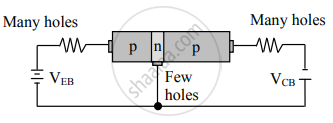
Figure (a) - At the instant when the EB junction is forward biased, holes in the emitter region have not entered the base region as shown in figure (b).
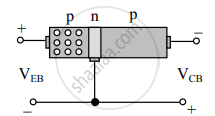
Figure (b) - When the biasing voltage VBE is greater than the barrier potential (0.6 – 0.7 V for Si transistors), many holes enter the base region and form the emitter current IE as shown in figure (c).
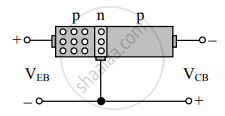
Figure (c) - These holes can either flow through the base circuit and constitute the base current (IB), or they can also flow through the collector circuit and contribute towards the collector current (IC).
- The base is thin and lightly doped, the base current is only 5% of IE.
- Holes injected from the emitter into the base diffuse into the collector-base depletion region due to the thin base region. When the holes enter the collector-base depletion region, they are pushed into the collector region by the electric field at the collector-base depletion region. The collector current (IC) flows through the external circuit as shown in figure (d). The collector's current IC is about 95% of IE.
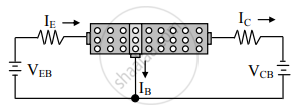
Figure (d)
From the figure, we can conclude that IE = IB + IC Since the base current IB is very small we can write IC ≈ IE.
APPEARS IN
संबंधित प्रश्न
Derive the relation between α and β.
Which method of biasing is used for operating a transistor as an amplifier?
For a transistor β =75 and IE = 7.5 mA. The value of α is ______
Draw the circuit symbol of the PNP transistor.
For a transistor IC = 15 mA, IB = 0.5 mA. What is the current amplification factor?
With the help of a neat circuit diagram, explain the transistor as an amplifier?
The output of the following circuit is 1 when the input ABC is

Give the Barkhausen conditions for sustained oscillations.
Explain the need for a feedback circuit in a transistor oscillator.
Assuming VCEsat = 0.2 V and β = 50, find the minimum base current (IB) required to drive the transistor given in the figure to saturation.
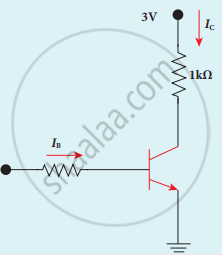
A transistor has a voltage gain A. If the amount βA of its output is applied to the input of the transistor, then the transistor becomes oscillator, when ______.
The condition to convert an amplified signal into an oscillating signal is ______
A transistor having α = 0.8 is connected in common emitter configuration. When the base current changes by 6 mA, then the change in collector current is ______.
If l1, l2, l3 are the lengths of the emitter, base and collector of a transistor, then ____________.
In the study of transistor as an amplifier, the ratio of collector current to emitter current is 0.98 then the ratio of collector current to base current will be ______.
Ve, Vb, and Ve are emitter, base, and collector voltage respectively for npn transistor in CE mode. Amplifier works for the combination of biasing voltage equal to ______.
In a transistor in CE configuration, the ratio of power gain to voltage gain is ____________.
In switching circuit, transistor is in ON state, values of IE and lB are 10 mA and 0.8 mA respectively and RL is 2 k`Omega`. If VCE is 7.6 V, then VCC is ____________.
A pnp transistor is used in common-emitter mode. If a change of 40 µA in base current brings a change of 2 µA in collector current with 0.04 V in base-emitter voltage, then the input resistance is ____________.
In transistor amplifier, base-emitter junction is forward biased and collector emitter junction is reverse biased. The current gain is ______.
In the case of transistor, the relation between current ratios αdc and βdc is ______.
In common emitter mode of transistor, the d.c. current gain is 20, the emitter current is 7 mA. The collector current is ______.
A transistor is connected in C - E mode. If collector current is 72 × 10-5 A and α = 0.96, then base current will be ______.
For an ideal diode, the current in the following arrangement is ______.

In the common-emitter configuration of a transistor, the current gain is more than 1 because [lb, le, and lc are base, emitter, and collector currents respectively] ______
In a p-n-p transistor circuit, the collector current is 10 mA. If 90% of the holes emitted from the emitter reach the collector, ______.
Explain the working of the n-p-n transistor in a common base configuration.
In a CE amplifier, the current gain is 80 and the emitter current is 9 mA. The base current is ______.
